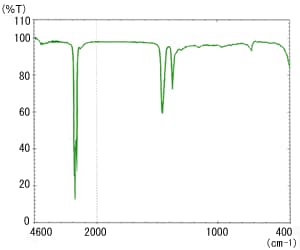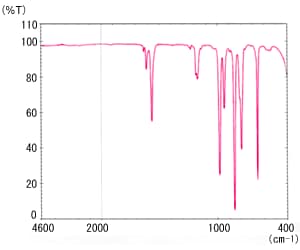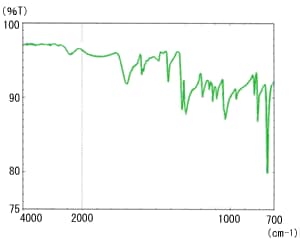Powder Samples
■ Introduction
Infrared spectroscopy incorporates several types of measurement method, such as the diffuse reflection method and attenuated total reflection method. The measurement method used must be selected according to the sample form. From the sample viewpoint, it is possible to use more than one method to measure an infrared spectrum for a single sample. Here we introduce the measurement methods to adopt when focusing on a single sample form.
On this first page, we focus on powder samples. The classical methods are the KBr pellet method and the Nujol method. However, as FTIR has become more common, the diffuse reflection method has become widely used. Attenuated total reflection (ATR) is a method that allows the direct measurement of powder samples. These measurement methods and preparation methods are described below.
■ KBr Pellet Method
This method exploits the property that alkali halides become plastic when subjected to pressure and form a sheet that is transparent in the infrared region. Potassium bromide (KBr) is the commonest alkali halide used in the pellets. Cesium iodide (CsI) may also be used to measure the infrared spectrum in the 400 to 250 cm-1 low-wavenumber region.
The preparation method for 13 mm-diameter pellets is described below. Approximately 0.1 to 1.0 % sample is well mixed into 200 to 250 mg fine alkali halide (the example of KBr is used below) powder and then finely pulverized and put into a pellet-forming die. A force of approximately 8 tons is applied under a vacuum of several mm Hg for several minutes form transparent pellets. Degassing is performed to eliminate air and moisture from the KBr powder. Inadequate vacuum may result in easily broken pellets that scatter light. Before forming the KBr powder into pellets, pulverize it to 200 mesh max. and then dry at approximately 110 °C for two to three hours. Note that rapid heating can oxidize some of the KBr powder to KBrO3, causing a brown discoloration. After drying the powder, store it in a desiccator.
When performing measurements, the background can be measured with an empty pellet holder inserted into the sample chamber. However, background measurements on a pellet holder with a pellet of KBr only, that contains no sample, can correct for infrared light scattering losses in the pellet and for moisture adsorbed on the KBr.
■ Nujol Method
This is a method for measuring powder samples with simple sample pretreatment. The sample is distributed in a liquid of approximately equal refractive index, and the infrared spectrum is measured. Generally, the powder is dispersed in non-volatile liquid paraffin (Nujol) that has low absorption in the infrared region.
To prepare a sample, pulverize approximately 10 mg sample powder in a mortar and pestle. Add one or two drops of liquid paraffin and mix to distribute the sample powder in the liquid paraffin. Apply the paste to a liquid cell (KBr crystal plate, etc.) and sandwich it under another cell plate.
Since liquid paraffin exhibits absorption near 3000 to 2800 cm-1, 1460 cm-1, 1375 cm-1, and 730 cm-1 as shown in Fig. 1, hexachlorobutadiene is used to confirm the sample absorbance in these regions. Fig. 2 shows the infrared spectrum of hexachlorobutadiene.

Fig. 1 Infrared Spectrum of Liquid Paraffin

Fig. 2 Infrared Spectrum of Hexachloro-1,3-Butadiene
■ Diffuse Reflection Method
When light is shone onto a powder sample, some of the light undergoes specular reflection at the powder surface and other light enters the sample and reappear from the surface as diffuse reflected light after repeated transmission and reflection. The diffuse reflection method is used to obtain spectrum using the diffuse reflected light. When measuring an infrared spectrum using the diffuse reflection method, the sample powder is normally not measured directly but diluted in an alkali halide, such as KBr. However, pretreatment is easy, as it is not necessary to form the sample powder into pellets, as for the KBr pellet method.
With this measurement method, background measurement is first performed on the KBr or other diluent powder packed into the sample plate of the diffuse reflectance accessory. Next, the sample powder is diluted to 0.1 % to 10 % in the KBr powder and packed into the sample plate for infrared spectrum measurement. Small volumes of sample can be measured after filling the sample plate with KBr powder and putting the sample powder mixed with a small quantity of KBr powder onto it. Just 50 to 100 ng of the carefully prepared sample can be analyzed.
As the diffuse reflected light has undergone repeated transmission, the absorption is analogous to the transmission spectrum. However, as the light is repeatedly transmitted through the sample, the low absorption bands are emphasized in comparison with the transmission spectrum. Therefore, Kubelka-Munk transformation has to be applied to the diffuse reflectance spectrum obtained to permit comparison to the transmission spectrums and quantitative handling.
■ Attenuated Total Reflection (ATR) Method

Fig. 3 IR Spectrum of Nicotinic Acid by ATR Method
The methods above measure the infrared spectrum for powder samples mixed in a medium such as KBr or liquid paraffin. However, ATR method is able to measure powder samples directly. Attenuated total reflection (ATR) method involves pressing the sample against a high-refractive-index prism and measuring the infrared spectrum using infrared light that is totally internally reflected in the prism. A zinc selenide (ZnSe) or germanium (Ge) prism is used in the ATR accessory.
In comparison with the methods described above, ATR method is an excellent method for obtaining infrared information for the powder sample surface. However, care is required with the wavenumber dependency of the absorption peak intensity and with the peak deformation toward the first-order differential form due to the anomalous dispersion of the refractive index for inorganic and other high-refractive-index samples.
Fig. 3 shows the measurement of a powder sample by ATR method.
■ Conclusions
The page above described measurement methods that can be applied to powder samples. Multiple measurement methods can be applied to a single sample form. Therefore, it is necessary to select the measurement method that is best suitable for the application and its purpose. Further measurement methods and sample preparation methods for various samples will be introduced in this series.






